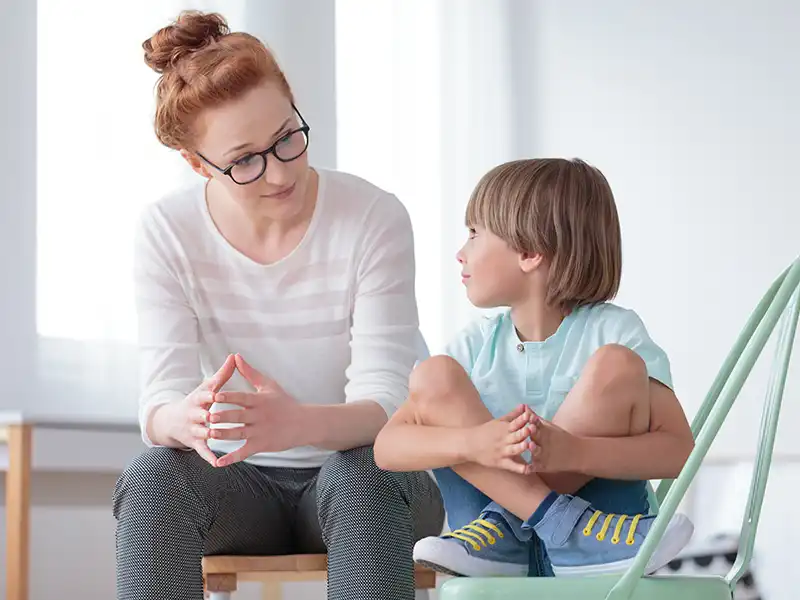Conversations help us connect – and they can often be fun. Open and meaningful conversations foster a strong relationship, and provide a safe space for kids to share their thoughts, feelings, and concerns.
Kids are more likely to open up and share their experiences when children feel heard and valued. Here are 10 tips to help you have great conversations with kids.
1. Create a safe environment
Children need to feel comfortable expressing themselves. Ensure that your child knows they won’t face judgment or punishment for sharing their thoughts.
2. Actively listen
Make an effort to give your child your full attention. This isn’t always possible as a busy parent or carer, but try to allocate regular time to connect with your child.
Take time to put your phone away, and really listen to your child. Use verbal cues like “I see” or “Tell me more” to show you are engaged.
3. Lead by example
Demonstrate good communication with your partner and others. Show them how respectful and healthy conversations work.
4. Choose the right time and place for serious conversations
Avoid discussing important issues when everyone is busy or distracted. Find a quiet, comfortable setting where you can talk without interruptions.
5. Conversations with kids should be age-appropriate
Tailor your discussions to their developmental stage.
Use language your child can understand, being clear and straightforward. This doesn’t necessarily mean avoiding new words, as this is how children and young people develop their vocabulary. But it might mean you check in to make sure your child understands what you’re trying to say or if they have any questions.
Sometimes, you’ll need to address challenging or uncomfortable topics. Be honest and age-appropriate in your approach. Encourage questions and provide accurate information.
6. Try to be non-judgmental
Children may reveal their mistakes or concerns. It’s important not to judge or criticise them. Shaming a child or teen can have lasting repercussions on their trust, self-image, and mental health.
Instead, offer support and guidance. Ideally, help them find their own constructive way to deal with the issue now, or discuss how they could best manage face a similar issue in the future. You can even roleplay scenarios to help them practise.
7. Be mindful of your child’s needs
Meet your child where they’re at, rather than expecting them to meet you where you’re at. It might mean tailoring your conversation because your child is tired and irritable. Or even allowing your child listen while playing with a fidget toy while they talk. And even if you have to calmly repeat or rephrase your words several times to be understood.
8. Ask open-ended questions
Ask questions that encourage conversation rather than simple yes or no answers. Open-ended questions like, “How did that make you feel?” can lead to deeper discussions.
9. Share your stories
Sharing your own experiences can make your child feel more comfortable sharing theirs. This can also be an opportunity to reflect on what you learned. Stories are also at the heart of what connects humans – and your stories are likely to stick in your child’s mind much more than your words.
10. Validate your child’s feelings
Show empathy. Let your child know it’s okay to feel the way they do, even if you don’t agree. This validation can strengthen your bond.
Children are still developing their emotional literacy. You can help by introducing language that helps identify and describe different feelings.
You can also role model by talking about how you feel, and acknowledging when you make mistakes. ‘Sorry’ is a powerful word; use it when you lose your cool, which shows you’re human too.
11. Respect privacy
Respect your child’s need for personal space and boundaries. They will need more privacy as they age. Don’t pry or invade their privacy – and make sure you don’t breach their trust if they ask you not to share something they have told you.
12. Put the screens away
Set screen-free zones and times for the family to ensure technology doesn’t interfere with quality conversations.
Check out our conversation cards
We have a free set of conversation cards for parents and carers to use with their kids. Print and cut them out. They’re designed to prompt fun conversations with your family. We develop these each year as part of our annual Talk-And-Walk-A-Thon campaign – but they can be used around the dinner table or any setting you choose.
FAQs
1. How can I get my child to open up and talk to me?
Encourage open communication by creating a non-judgmental and safe space. Show genuine interest in what they have to say.
2. What should I do if my child refuses to talk about certain topics?
Respect their boundaries and give them time. Reassure them that you are there to support and listen when they are ready.
3. How can I handle sensitive topics like puberty or relationships?
Approach such subjects with empathy and age-appropriate information. Be honest and prepared to answer their questions.
4. What if my child prefers texting or messaging over face-to-face conversations?
Embrace technology as a tool for communication but set limits on screen time and maintain some face-to-face conversations.
5. How can I balance work and family time to have meaningful conversations with my children?
Schedule family time and make it a priority. Quality matters more than quantity. Use this time for open discussions and bonding.
Improve school-wide student wellbeing
Better support student mental health through a peer-led approach to wellbeing, trusted by 620+ schools Australia-wide.





